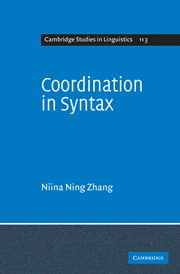Book contents
3 - The categorial makeup of coordinate complexes
from PART II - NO SPECIAL SYNTACTIC CATEGORY
Published online by Cambridge University Press: 04 August 2010
Summary
Introduction
One clear fact about coordinate constructions is that the category of the whole complex is identical to at least one of the conjuncts. The goal of this chapter is to determine the syntactic computation behind this categorial feature unification.
I follow the traditional assumption that major parts of speech are composed of categorial features, and the categorial features of a nominal are [+N, −V], the categorial features of a verb are [−N, +V], the categorial features of an adjective are [+N, +V], and so on.
In the theoretical syntax literature on coordination, it has long been proposed that coordinators are head elements (De Groot 1949: 112, 222–223; Pesetsky 1982; Thiersch 1985; Munn 1987; 1992; 1993; Woolford 1987; Collins 1988a; 1988b; Kolb and Thiersch 1991; Anandan 1993: 38; Kayne 1994; Johannessen 1998; Zoerner 1995; see also Dik's 1968: 53 review of De Groot's proposal and Progovac's 1998a; 1998b review of later proposals). As we know, the categorial features of a complex element are projected from the head of the complex. However, unlike other head elements, coordinators such as and do not have any categorial features. Thus the recognition that coordinators are head elements does not account for the fact that the category of the whole coordinate complex is identical to at least one of the conjuncts.
From the perspective of the structure of coordinate constructions, coordinate complexes have a complementation structure in which one conjunct is in the complement position (called the internal conjunct in Chapter 2) and the other conjunct(s) is/are in the Specifier position(s) (called the external conjunct in Chapter 2).
- Type
- Chapter
- Information
- Coordination in Syntax , pp. 43 - 76Publisher: Cambridge University PressPrint publication year: 2009



